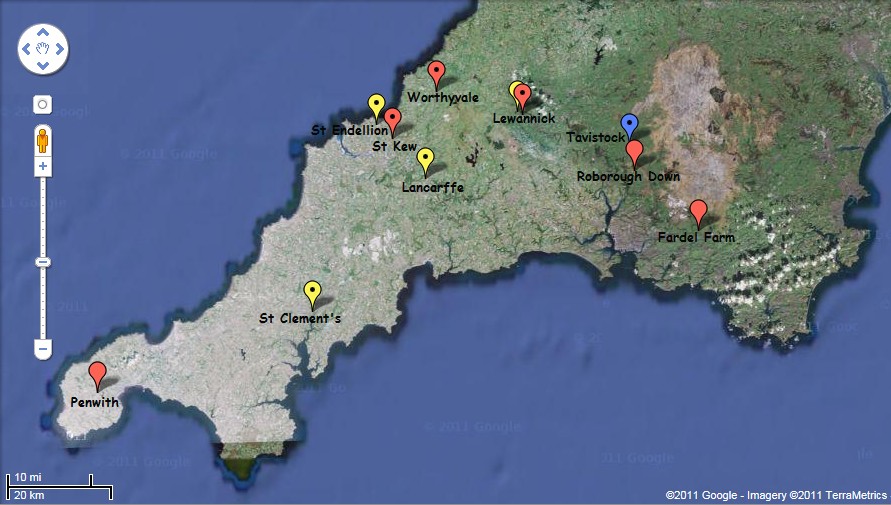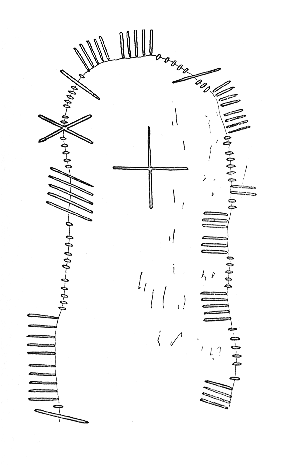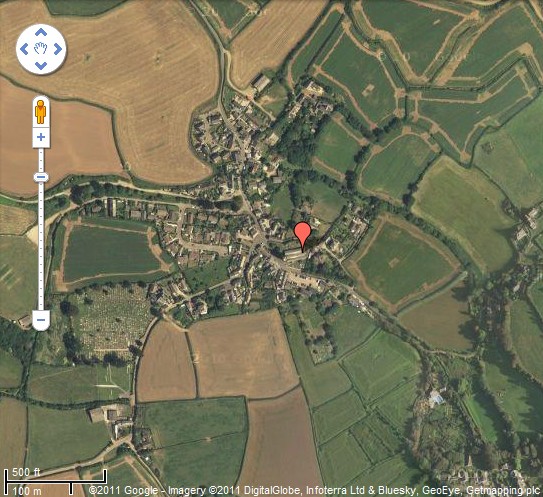BabelStone Blog
Sunday, 15 November 2009
The Penwith Ogham Stone
It is not often that a new Ogham stone is discovered, so when last week someone asked me to take a look at a piece of slate with a possible Ogham inscription on it that they had just found, I was excited, but not overly hopeful that it would turn out to be a genuine Ogham inscription. I frequently get people sending me pictures of various artefacts to identify, and nine times out of ten the object is not what they expected. And in this case, it would have been so easy for someone to have optimistically mistaken random scratches or natural marks on a stone for the strokes of Ogham letters. However, as soon as I saw the stone in question I felt certain that this was indeed a fragment of a genuine Ogham-inscribed stone, and a thing of great rarity.
The stone was found by an anonymous but responsible metal detectorist (who immediately reported the find to the appropriate archaeological authorities) on the day of Guy Fawkes Night in a ploughed field near a church somewhere on the Penwith peninsula in the far west of Cornwall. The exact location of the find is not being revealed for the time being, so the tag on the map below is only very approximately placed.
Location of Ogham Stones in Cornwall and Devon
The red tag marked PNWTH is the approximate site of the Penwith Ogham stone
As can be seen from the map (where red tags mark certain Ogham inscriptions, and yellow tags mark dubious or unconfirmed Ogham inscriptions), this find is much farther west than the other known Ogham inscriptions in Cornwall and Devon (ancient Dumnonia). The fact that no Ogham stones have been found in this part of Cornwall previously is perhaps not particularly significant, and may just reflect the random chance of archaeological preservation. Certainly the west of Cornwall was as much (if not more) open to Irish influence than the east of Corwall was (St Ives is named after the Irish missionary Saint Ia, and St Erth is named after the Irish missionary Saint Erc). What may be significant is that the stone was found in a field near an ancient church, as very many Ogham stones in Wales and Cornwall are located in churchyards or churches (often built into the structure of the church). In some cases Ogham stones have been moved to the local church from their original location elsewhere, but in most cases it seems likely that they were originally set up in or near churches as memorials for the dead or as grave markers (the Cornish Ogham stones of Ulcagnus and Latinus also have Latin inscriptions reading hic iacit ... "here lies [the body of] ..."). But if Ogham stones are naturally found in churches and churchyards, why was this fragmentary Ogham stone found some distance from the nearby church? My suspicion is that the stone would originally have been located in the churchyard, but at some time (medieval or post-medieval) the strange and unreadable Ogham inscription could have been denounced as the writing of the devil, and the stone broken up and thrown out into the fields. Other Ogham stones in churchyards (such as the two examples at Lewannick) could have escaped this fate because they also had a parallel Latin inscription, which would have made them seem less suspect (on the other hand, the St Kew Ogham stone, which has parallel Ogham and Latin inscriptions, was found in a stream near the church, and so may have been thrown out of the holy ground irrespective of its Latin inscription).
The stone itself is a small fragment (about 13 × 8 cm) of what must originally have been a much larger stone. The inscription is only a tantalizing fragment comprising a few letters that breaks off at both ends. The break at one end is still fresh, and was presumably made during recent ploughing. At least the piece of stone broken off at the freshly broken edge must still be somewhere in the field, but as yet it has not been found.
The Penwith Ogham Stone
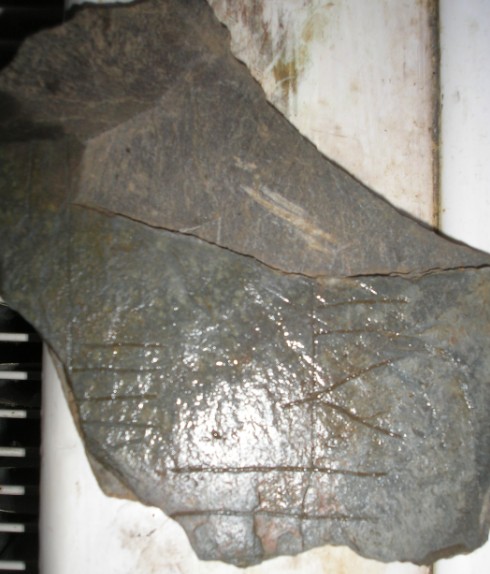
Click on image of stone to show an overlay of the inscription
[Picture of stone courtesy of its finder]
Although the inscription is too fragmentary to make out much of a reading, it has several interesting features. First and foremost, the Ogham inscription is not written along the edge (arris) of the stone, using the edge as a natural stemline, as is the case in the vast majority of Ogham inscriptions, but is inscribed upon the face of the stone using two artificial stemlines. Ogham stones with inscriptions on the face of the stone (known as "scholastic" inscriptions) have traditionally been considered to be of a later date than the classical edge-inscribed Ogham stones (4th - 8th centuries). However, I am beginning to doubt that surface-inscribed Ogham stones are necessarily later in date than edge-inscribed Ogham stones. The Silchester Ogham Stone, which has been dated to the period 350-425, has a surface-inscribed Ogham inscription; and although in this case the surface inscription was probably not a matter of choice but of necessity as the pre-existing Roman column on which the inscription was made had no angular edges, it still proves that inscriptions on artificial stemlines could and did occur at a very early date. Coincidentally, the previous Ogham stone discovery that I am aware of, a small slate slab that was unearthed from a site on the Isle of Man during Summer 2006 for an episode of Time Team, is also a surface-inscribed Ogham stone. Significantly, to my mind, both the Penwith stone and the Isle of Man stone are composed of slate, so perhaps the flakiness of slate means that it is less suitable for inscribing Ogham along the edge: notching the strokes of the Ogham letters along the edge of slate might cause the edge to crumble and the Ogham letters fall apart (an experiment needs to be carried out). Thus it is possible that the surface inscriptions of the Isle of Man and Penwith Ogham stones are more a reflection of the stone used rather than their date.
The fragment of inscription that can be seen on the Penwith stone is made on two (or possibly three) artificial stemlines. As with many Ogham inscriptions, the symmetric nature of the Ogham script means that it is not immediately obvious which direction to read the Ogham text (Ogham stone inscriptions normally read bottom-to-top up the edge of the stone, but if the stone is not standing in situ it may not be evident which is the top and which is the bottom of the stone). In the case of the Penwith stone, I think that the key to reading the inscription are the two diagonal lines forming a V-shape on the righthand stemline. In some Ogham inscriptions the strokes emanating out from the stemline are quite irregular, and horizontal strokes may be at an angle; but given how neatly and parallel the other horizontal strokes on this inscription are, it seems to me that the V-strokes must be deliberate rather than accidental. But what Ogham letter is written as a V-shape? Well, although none of the twenty basic Ogham letters are written like this, there are two supplementary letters that are similar to the V-shaped letter on the Penwith stone :
- Éabhadh or Ébhadh ᚕ [two diagonal lines crossing at the stemline]
- Ifin or Iphin (earlier Pin, from Latin pinus "pine" or spina "thorn" ?) ᚘ [two overlapping diagonal crosses to the right of the vertical stemline]
[NB If the Ogham text on this page shows up as square boxes on your browser, then please install the BabelStone Ogham Fonts or another Unicode Ogham font, and reload the page.]
The five supplementary letters (Forfeda) only occur rarely on Ogham stone inscriptions, where they mostly represent sounds not present in Primitive Irish, and for which there was no basic Ogham letter. Medieval scholars later repurposed these five letters to represent a series of diphthongs.
The X-shaped letter Éabhadh (the first supplementary letter) is the most frequently used supplementary letter. It was originally used to represent /k/, mostly in the spelling of the deictic particle koi (which corresponds semantically to the Latin phrase hic iacit "here lies"), and only occasionally in other words. These are all the known examples of the use the word koi ᚕᚑᚔ in Ogham stone inscriptions :
- BUKIL/1 (Bunkilla, Cork)
- COLIN/4 (Colbinstown, Kildare) [CIIC #22]
- DNMOR/1 (Donaghmore, Kildare) [CIIC #26] : doubtful
- LEGAN/1 (Legan, Kilkenny) [CIIC #34]
- BALBO/1 (Ballyboodan, Kilkenny) [CIIC #38]
- DNARD/1 (Donard, Wicklow) [CIIC #48]
- BAHAN/2 (Ballyhank, Cork) [CIIC #98]
- MONAT/3 (Monataggart, Cork) [CIIC #120]
- BLTAG/2 (Ballintaggart, Kerry) [CIIC #156]
- BLTAG/9 (Ballintaggart, Kerry) [CIIC #163]
- NEWT/1 (Newton, Aberdeenshire) : this inscription is difficult to read, and the letter in question is either read as 'K' in Irish koi or 'P' in Pictish ipo "nephew"
(Ballintaggart, County Kerry)
ᚋᚐᚊᚊᚔᚔᚐᚏᚔᚕᚑᚔᚋᚐᚊᚊᚔᚋᚒᚉᚉᚑᚔᚇᚑᚃᚃᚔᚅᚔᚐᚄ
(MAQQI-IARI KOI MAQQI MUCCOI DOVVINIAS)
These are some of the few examples where the letter Éabhadh may represent a /k/ sound in words other than koi:
- COOLM/1 (Coolmagort, Kerry) [CIIC #197]
- WHFLD/2 (Whitefield, Kerry) [CIIC #216] : but Macalister states that this letter is more plausibly a mistake for the letter P, drawn on the stemline instead of to one side
- BURIN/1 (Burrian, Orkney) : here the X-shaped letter has also been interpretted as a P
In the later manuscript Ogham tradition the X-shaped letter is used to represent the diphthong ea, and this vocallic value is represented in quite a few, mostly relatively late, inscriptions, where this letter represents /e/ :
- COOGH/1 (Aghabulloge, Cork) [CIIC #104]
- COOLH/1 (Cooldorragha, Cork) [CIIC #129]
- CLCAH/1 (Cloghanecarhane, Kerry) [CIIC #230]
- COOLM/5 (Coolmagort, Kerry) [CIIC #201]
- KLGRO/1 (Killogrone, Kerry) [CIIC #235]
- KMKDR/3 (Kilmalkedar, Kerry) [CIIC #187]
- LETWE/1 (Calluragh Burial Ground, Kerry) [CIIC #239]
- PRKLA/1 (Parknasilla, Kerry) [CIIC #223]
- TINAH/2 (Tinnahally, Kerry) [CIIC #256]
- LTING/1 (Lunnasting, Shetland)
Given the relatively frequent occurence of the letter Éabhadh, it is possible that the V-shaped letter on the Penwith stone is a malformed or damaged form of this letter, especially as the two diagonal strokes do slightly cross the stemline, looking as if they could extend across and form an X-shape. Without having examined the stone in hand, I cannot be sure that the two diagonal strokes forming one half of the X have not been lost by damage to the stone, but the photograph that I have does not appear to show any signs of damage. Thus I am reluctant to interpret the strokes as representing the letter Éabhadh. There is also no precedent for a southern British Ogham stone using the letter Éabhadh, either as a consonant or as a vowel: all the certain consonantal occurences are restricted to Ireland, and all the vocallic occurences are limited to Ireland and the far north of Scotland. A further argument against this letter is the fact that as a consonant it almost always occurs in the word koi, which is almost always preceded by a personal name ending in a vowel, and thus the letter Éabhadh representing /k/ is almost always preceded by and followed by a vowel letter; but in the Penwith stone the letter above it is clearly not a vowel (two horizontal strokes). It is also unlikely to be vocallic letter Éabhadh, as vocallic usage of the letter is typical of relatively late inscriptions, and the Dumnonian Ogham stones are all fairly early in date. So all in all, I am doubtful that the V-shaped letter is the letter Éabhadh.
The other possiblity is that the V-shaped letter on the Penwith stone is a variant form of the letter Ifin (the fourth supplementary letter). As Primitive Irish lacked a /p/ sound, none of the twenty basic Ogham letters correspond to the Latin letter P, and so this letter was devised in order to represent /p/ in Latin, Brythonic and Pictish names. It was later repurposed as the diphthong /io/ by medieval scholars, and a new letter Peith ᚚ introduced to represent /p/ in its place. This letter is found with its original /p/ value in at least three inscriptions, one in Ireland and two in Wales (the X-shaped letter in the NEWT/1, WHFLD/2 and BURIN/1 inscriptions listed above may also be the letter Ifin) :
| COOLE/1 | CRCKH/1 | KENFG /1 |
| (Cool East, County Kerry) | (Crickhowell, Brecknockshire) | (Kenfig, Glamorganshire) |
 |
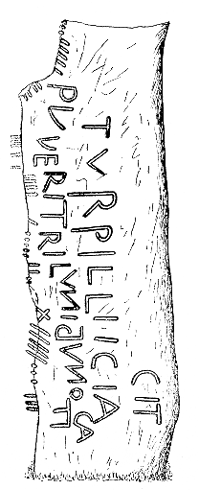 |
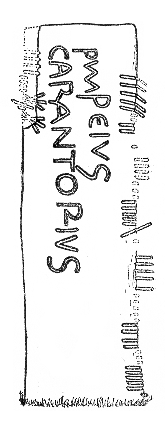 |
| ᚂᚑᚌᚔᚈᚈᚔᚋᚐᚊᚔᚓᚏᚘᚓᚅᚅ | ᚈᚒᚏᚘᚔᚂᚔᚋᚑᚄᚐᚉᚈᚏᚐᚂᚂᚑᚅᚔ | ᚘᚐᚋᚘᚓᚄ ᚏᚑᚂᚐᚉᚒᚅᚋᚐᚊᚔᚂᚂᚒᚅᚐ |
| (L[OGIT]TI MAQI ERPENN) | (TURP[I]L[I] [MOSAC?] [TRA]LL[O]NI) | (P[AM]P[E]S | ROL[ACU]N M[A]Q ILLUNA) |
| [the name Erpenn may be a hybrid of Pictish Erp and the Irish diminuitive -én] | [the name Turpillius is Latin] | [the name Pampes or Popias seems to be a Celticized version of Pompeius] |
As can be seen from the above three inscriptions, the Ogham letter Ifin representing /p/ was simplified from its later manuscript glyph form ᚘ (two overlapping diagonal crosses) to either an X-shape or a V-shape with a vertical line between the two diagonal strokes. I believe that the V-shaped letter in the Penwith inscription may well be a variant form of this same letter. The bottom of the lefthand stem also shows two partial, converging diagonal strokes, and these may also represent the same letter P (in this case it looks as if the two strokes would cross before reaching the stemline, thus making an X-shape to the side of the stemline, which would be the more correct way of writing the letter). As the letter Ifin is used in two Welsh inscriptions for representing the letter P in Latin names, and as three out of the six other Ogham stones from Cornwall and Devon comemmorate people with Latin names (Ingenuus, Iustus and Latinus), it does not seem unreasonable to suppose that the Penwith stone might comemmorate someone with a Latin name, and if that Latin name was spelled with the letter P, then the Ogham letter Ifin would be required to represent it in the Ogham version of his name. Therefore, I interpret the V-shaped letter on the Penwith stone as the letter Ifin representing a /p/ sound.
As the letter Ifin ᚘ protrudes to the right of a vertical stemline, we can use this letter to orientate the stone (in the orientation shown in the picture above, which is rotated 90 degrees clockwise from the original photograph), and thence know how to read the other Ogham strokes on the stone. There are two or possibly three parallel stemlines on this fragment, and on the basis of the Silchester Ogham Stone which has two parallel stemlines that read bottom-to-top from left to right, I assume that the stemlines on the Penwith stone should be read left to right.
On the lefthand stem, reading bottom-to-top :
- the two partial, converging diagonal strokes may form the letter P or they may be part of a completely different letter;
- the four horizontal strokes protruding to the right form the letter S.
On the righthand stem, reading bottom-to-top :
- I take the two or three horizontal strokes crossing the stemline to be the strokes of a vowel letter, O/U/E/I depending upon how many preceding strokes have been lost (these strokes extend much further to the left than they do to the right, which is somewhat unusual, and look long enough to be the strokes of an M-series letter, but because they are perfectly perpendicular to the stemline I think that they must be the strokes of a vowel letter);
- the two converging diagonal strokes form what I take to be the letter P;
- the two horizontal strokes protruding to the right form the letter L/F/S/N depending upon how many following strokes have been lost (because only the letter L would naturally follow the letter P, I think that it is most likely to be the letter L).
There is a third possible stemline to the left of the left stem line, with a single perpendicular crossing stroke that could conceivably be the letter A, but as the stemline is so close to the left stemline it may be the remains of an aborted inscription, or it may not be part of an Ogham inscription at all. For the time being, I shall ignore it.
This then is my very tentative reading of the fragmentary inscription on the Penwith stone :
ᚘᚄ
ᚑᚘᚂ
... P? S | {O~I} P L ... )
It's not much to go on, but if I had to guess I would suggest that the righthand stem shows the last three strokes of the last letter of Primitive Irish maqi ᚋᚐᚊᚔ "son of" followed by a Latin name beginning with Pl... ... but unless another piece of the stone is found we will never know for sure what the inscription originally said.
Addendum 1 [2009-12-21]
The Ogham stone finder has kindly supplied my with some better quality images of the stone, which I reproduce below (at a reduced resolution).
The Penwith Ogham Stone : Stemline A
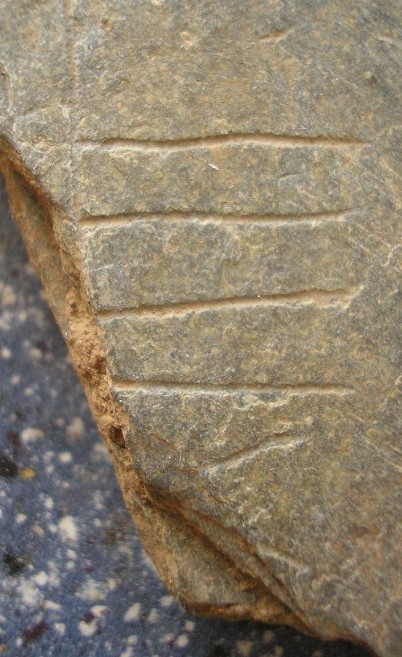
Click on image of stone to show an overlay of the inscription
Extending the stemline down and extending the two diagonal strokes (click on the above image or click here to open in a new window) shows that the bottom right letter is formed as an X-shaped cross to the right of the stemline, which can only be the letter Ifin ᚘ representing a /p/ sound.
The four horizontal strokes to the right of the stemline are probably the letter S ᚄ, but as the stone to the left of the stemline is broken off, they could conceivably be the vowel letter E ᚓ. There appears to be a hint of a line to the left of the stem next to the topmost horizontal stroke, but at high resolution (see image below) this looks like a natural feature of the stone, and not a carved stroke.
The Penwith Ogham Stone : Detail of Stemline A
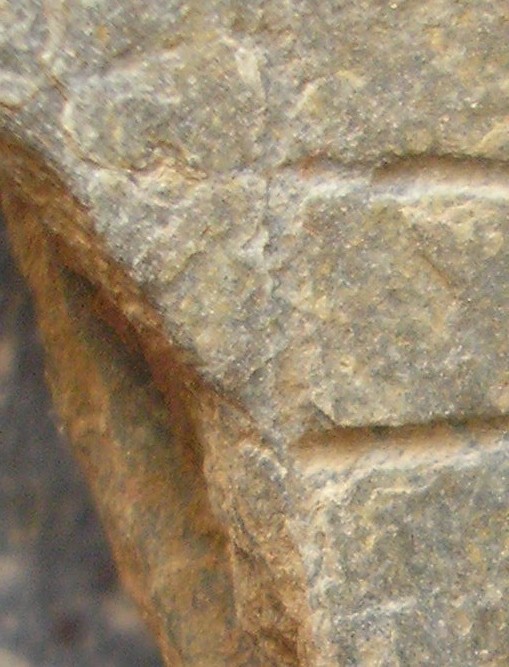
The Penwith Ogham Stone : Stemline B
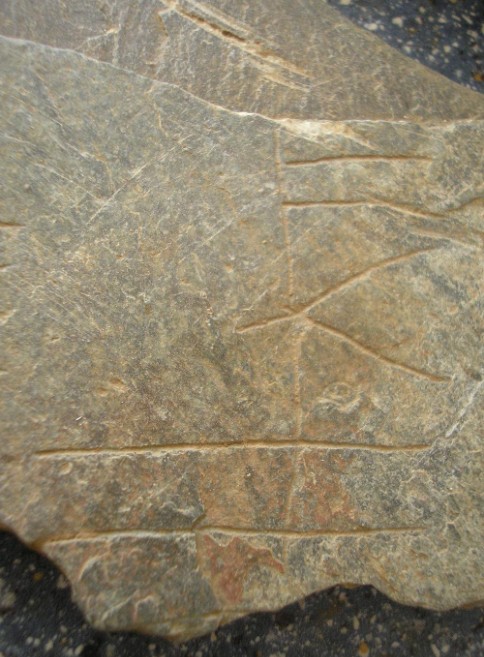
Click on image of stone to show an overlay of the inscription
I am still very much uncertain about the two diagonal crossing strokes. They may be a badly carved letter Ifin representing a /p/ sound (open reconstruction in a new window), or they may be the letter Éabhadh ᚕ, representing a /k/ or /e/ sound, with the two diagonal strokes on the left of the stemline lost because of damage to the stone (open reconstruction in a new window). However, at high resolution (see image below) it is difficult to see any damage that would account for the loss of the two strokes to the left of the stem but not affect the adjacent left horizontal strokes.
The Penwith Ogham Stone : Detail of Stemline B
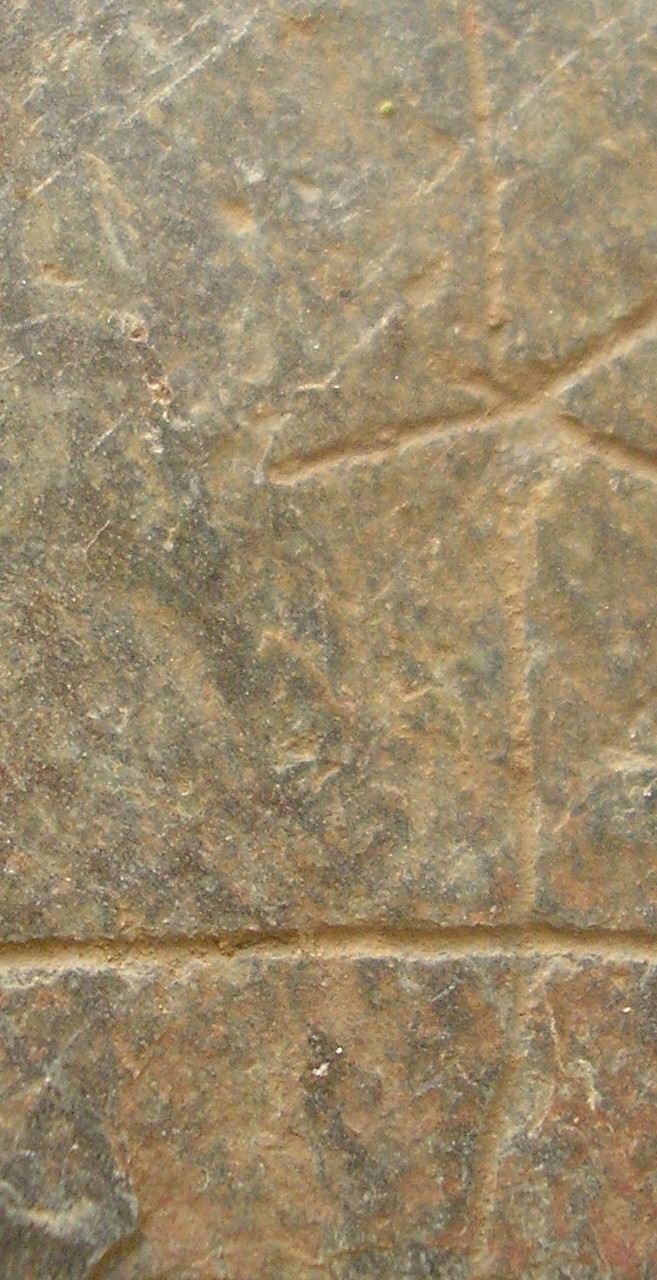
The Penwith Ogham Stone : Stemline C
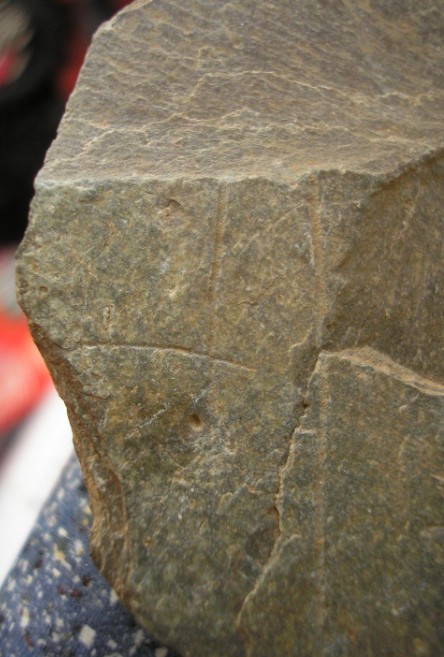
Click on image of stone to show an overlay of the inscription
This appears to show a single vowel letter A, with the same assymetry as seen in Stemline B (vowel strokes are twice as long to the left of the stemline as they are to the right of the stemline). But as it is so close to the trailing end of Stemline A, and appears to have no adjacent letters, it is difficult to be sure whether it really is an Ogham letter or not.
Addendum 2 [2011-07-04]
Find Spot
I can now disclose that the Penwith Ogham stone was found in a field near the parish church of St Pol-de-Leon in the village of Paul at the south-east corner of the Penwith peninsula. The church was reputedly founded by Paul Aurelian, a 6th century Welsh saint.
Approximate Find Spot of the Penwith Ogham Stone
The red tag indicates Paul Parish Church. The Penwith Ogham stone was found in a nearby field.
Confirmed Ogham Inscription
The stone has now been confirmed as an Ogham stone by two leading oghamologists, Professor Charles Thomas and Dr Katherine Forsyth. Forsyth, who notes that the V-shaped letter may be a "P", has described the stone as a "really significant find". It is anticipated that a short article on the stone will be published in Cornish Archaeology.
What Now ?
I have to admit to being very disappointed, and just a little frustrated, that the Cornish archaeologists have not been more proactive in investigating this stone, as it is potentially a very significant find of national importance. The fact that there is a fresh break on the stone indicates that there is at least one more surviving fragment of this memorial stone somewhere in the field where it was found. The small fragment that we have now is not enough to give a reading, or even to determine what language the inscription is in, but if the broken part of this stone (and/or other fragments of the memorial) were to be recovered then a reading may be possible. If I were a Cornish archaeologist I would have been jumping up and down in excitement, and would have started excavations and/or field walking in the find field at the very earliest opportunity in order to find more fragments of the memorial and to determine an archaeological context for the find before the evidence is further destroyed by ploughing. It is baffling to an amateur like myself that there seems to be no local archaeological interest in trying to recover more fragments of this highly unusual Ogham stone. It is also very strange that the local Finds Liaison Officer does not seem to consider this find important enough to add to the Portable Antiquities Scheme Database. All I can hope is that an archaeologist with an interest in early Cornish history takes up the cause of this stone, and that one day an Ogham monument reconstructed from several fragments will be on display in a museum in Cornwall.
Index of BabelStone Blog Posts
